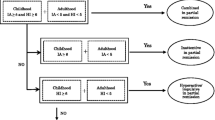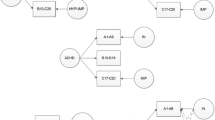Abstract
The American Psychiatric Association (APA) working group on Attention-Deficit/Hyperactivity Disorder (ADHD) proposed the inclusion of four new impulsivity symptoms. However, they were not included in DSM-5 due to the lack of sufficient evidence. The aim of this study is to investigate the performance of the proposed four ADHD impulsivity symptoms with respect to: (a) ADHD factor structure; (b) performance in predicting clinical impairment; (c) specificity for ADHD diagnosis and (d) best symptomatic threshold to predict clinical impairment. The sample comprised 416 children (31 ADHD subjects according to both DSM-IV and proposed DSM-5, 20 ADHD subjects according to just one diagnostic system and 365 controls) from 12 schools. Diagnoses were derived using semi-structured interviews and ADHD rating scales. Results from confirmatory factor analysis indicate that addition of the four new impulsivity items provided a slightly better factor structure if compared to models including only 18 items. Regression analyses showed that only one of the new impulsivity symptoms (impatient) was part of the list of best predictors of impairment. None of the four new impulsivity items was specifically associated with ADHD diagnosis. The best cutoff point in the hyperactivity/impulsivity dimension for predicting impairment did not change significantly. Overall, our findings suggest that the determination on how to best capture impulsivity dimension as part of the ADHD construct needs more investigation and that there is not enough evidence to include these four assessed impulsivity symptoms as part of the ADHD criteria.
Similar content being viewed by others
References
Polanczyk G, de Lima MS, Horta BL, Biederman J, Rohde LA (2007) The worldwide prevalence of ADHD: a systematic review and metaregression analysis. Am J Psychiatry 164(6):942–948. doi:10.1176/ajp.2007.164.6.942 (Epub 2007/06/02. PubMed PMID: 17541055)
Polanczyk GV, Salum GA, Sugaya LS, Caye A, Rohde LA (2015) Annual research review: a meta-analysis of the worldwide prevalence of mental disorders in children and adolescents. J Child Psychol Psychiatry 56(3):345–365. doi:10.1111/jcpp.12381 (Epub 2015/02/05. PubMed PMID: 25649325)
Faraone SV, Asherson P, Banaschewski T, Biederman J, Buitelaar JK, Ramos-Quiroga JA et al (2015) Attention-deficit/hyperactivity disorder. Nat Rev Dis Primers. doi:10.1038/nrdp.2015.20
Coghill D, Seth S (2011) Do the diagnostic criteria for ADHD need to change? Comments on the preliminary proposals of the DSM-5 ADHD and Disruptive Behavior Disorders Committee. Eur Child Adolesc Psychiatry 20(2):75–81. doi:10.1007/s00787-010-0142-4 (Epub 2010/11/25. PubMed PMID: 21107871)
Tannock R (2013) Rethinking ADHD and LD in DSM-5: proposed changes in diagnostic criteria. J Learn Disabil 46:5–25. doi:10.1177/0022219412464341 (PubMed PMID: 23144062. Epub 2012/11/9)
Association AP (2013) Diagnostic and statistical manual of mental disorders (DSM-5®). American Psychiatric Pub, Washington, DC
Wender PH, Ward MF, Reimherr FW, Marchant BK (2000) ADHD in adults. J Am Acad Child Adolesc Psychiatry 39(5):543. doi:10.1097/00004583-200005000-00001 (Epub 2000/05/10. PubMed PMID: 10802966)
Barkley RA, Fischer M (2010) The unique contribution of emotional impulsiveness to impairment in major life activities in hyperactive children as adults. J Am Acad Child Adolesc Psychiatry 49(5):503–513 (Epub 2010/05/01)
Matte B, Rohde LA, Turner JB, Fisher PW, Shen S, Bau CH et al (2015) Reliability and validity of proposed DSM-5 ADHD symptoms in a clinical sample of adults. J Neuropsychiatry Clin Neurosci 27(3):228–236. doi:10.1176/appi.neuropsych.13060137 (Epub 2015/06/13. PubMed PMID: 26067434)
Ghanizadeh A (2013) Agreement between diagnostic and statistical manual of mental disorders, fourth edition, and the proposed DSM-V attention deficit hyperactivity disorder diagnostic criteria: an exploratory study. Compr Psychiatry 54(1):7–10. doi:10.1016/j.comppsych.2012.06.001 (Epub 2012/07/20. PubMed PMID: 22809622)
Ercan ES, Bilac O, Uysal Ozaslan T, Rohde LA (2015) Is the prevalence of ADHD in Turkish elementary school children really high? Soc Psychiatry Psychiatr Epidemiol 50(7):1145–1152. doi:10.1007/s00127-015-1071-9 (Epub 2015/05/24. PubMed PMID: 26002410)
Ercan ES, Kandulu R, Uslu E, Ardic UA, Yazici KU, Basay BK, Aydın C, Rohde RA (2013) Prevalence and diagnostic stability of ADHD and ODD in Turkish children: a 4-year longitudinal study. Child Adolesc Psychiatry Ment Health 7:30. doi:10.1186/1753-2000-7-30
Chen C, Burton M, Greenberger E, Dmitrieva J (1999) Population migration and the variation of dopamine D4 receptor (DRD4) allele frequencies around the globe. Evol Hum Behav 20:309–324
Ercan ES, Amado S, Somer O, Çıkoğlu Set (2001) Development of a test battery for the assessment of attention deficit hyperactivity disorder. Turk J Child Adolesc Ment Health. 8(3):132–144
DuPaul GJ, Power TJ, McGoey KE, Ikeda MJ, Anastopoulos AD (1998) Reliability and validity of parent and teacher ratings of attention-deficit/hyperactivity disorder symptoms. J Psychoeduc Assess 16(1):55–68
Association AP (1994) Diagnostic and statistical manual of mental disorders. American Psychiatric Association, Washington DC, pp 471–475
Ercan ES, Suren S, Bacanli A, Yazici KU, Calli C, Ozyurt O, et al. Decreasing ADHD phenotypic heterogeneity: searching for neurobiological underpinnings of the restrictive inattentive phenotype. 2015 (updated Jun 10. 2015/06/11)
O’Neill S, Schneiderman RL, Rajendran K, Marks DJ, Halperin JM (2014) Reliable ratings or reading tea leaves: can parent, teacher, and clinician behavioral ratings of preschoolers predict ADHD at age six? J Abnorm Child Psychol 42(4):623–634. doi:10.1007/s10802-013-9802-4 (Epub 2013/10/03. PubMed PMID: 24085388; PubMed Central PMCID: PMCPMC3975808)
Magnusson P, Smari J, Gretarsdottir H, Prandardottir H (1999) Attention-Deficit/Hyperactivity symptoms in Icelandic schoolchildren: assessment with the Attention Deficit/Hyperactivity Rating Scale-IV. Scand J Psychol 40(4):301–306 (Epub 2000/02/05)
Kaufman J, Birmaher B, Brent D, Rao U, Flynn C, Moreci P et al (1997) Schedule for affective disorders and Schizophrenia for school-age children-present and lifetime version (K-SADS-PL): initial reliability and validity data. J Am Acad Child Adolesc Psychiatry 36(7):980–988. doi:10.1097/00004583-199707000-00021 (Epub 1997/07/01. PubMed PMID: 9204677)
Gökler B, Ünal F, Pehlivantürk B, Kültür EÇ, Akdemir D, Taner Y (2004) Reliability and validity of schedule for affective disorders and schizophrenia for school age children-present and lifetime version-turkish version (K-SADS-PL-T). Çocuk ve Gençlik Ruh Sağlığı Dergisi/Turk J Child Adolesc Ment Health. 11(3):109–116
Brotman MA, Schmajuk M, Rich BA, Dickstein DP, Guyer AE, Costello EJ, Egger HL, Angold A, Pine DS, Leibenluft E (2006) Prevalence, clinical correlates, and longitudinal course of severe mood dysregulation in children. Biol Psychiatry 60:991–997. doi:10.1016/j.biopsych.2006.08.042
Cho SC, Kim BN, Kim JW, Rohde LA, Hwang JW, Chungh DS, Shin MS, Lyoo IK, Go BJ, Lee SE, Kim HW (2009) Full syndrome and subthreshold attention-deficit/hyperactivity disorder in a Korean community sample: comorbidity and temperament findings. Eur Child Adolesc Psychiatry 18:447–457. doi:10.1007/s00787-009-0755-7
Kieling C, Kieling RR, Rohde LA, Frick PJ, Moffitt T, Nigg JT et al (2010) The age at onset of attention deficit hyperactivity disorder. Am J Psychiatry 167(1):14–16. doi:10.1176/appi.ajp.2009.09060796 (Epub 2010/01/14. PubMed PMID: 20068122; PubMed Central PMCID: PMCPMC4478075)
Polanczyk G, Caspi A, Houts R, Kollins SH, Rohde LA, Moffitt TE (2010) Implications of extending the ADHD age-of-onset criterion to age 12: results from a prospectively studied birth cohort. J Am Acad Child Adolesc Psychiatry 49(3):210–216 (Epub 2010/04/23)
L-T Hu, Bentler PM (1998) Fit indices in covariance structure modeling: sensitivity to underparameterized model misspecification. Psychol Methods 3(4):424
Wagner F, Martel MM, Cogo-Moreira H, Maia CR, Pan PM, Rohde LA et al (2015) Attention-deficit/hyperactivity disorder dimensionality: the reliable ‘g’ and the elusive ‘s’ dimensions. Eur Child Adolesc Psychiatry. doi:10.1007/s00787-015-0709-1 (Epub 2015/04/17. PubMed PMID: 25877403)
Barkley R (2010) Deficient emotional self-regulation: a core component of attention-deficit/hyperactivity disorder. J ADHD Relat Disord. 1(2):5–37
Kessler RC, Green JG, Adler LA, Barkley RA, Chatterji S, Faraone SV et al (2010) Structure and diagnosis of adult attention-deficit/hyperactivity disorder: analysis of expanded symptom criteria from the Adult ADHD Clinical Diagnostic Scale. Arch Gen Psychiatry 67(11):1168–1178. doi:10.1001/archgenpsychiatry.2010.146 (Epub 2010/11/03. PubMed PMID: 21041618; PubMed Central PMCID: PMCPMC3131739)
Matte B, Anselmi L, Salum GA, Kieling C, Goncalves H, Menezes A et al (2015) ADHD in DSM-5: a field trial in a large, representative sample of 18- to 19-year-old adults. Psychol Med 45(2):361–373. doi:10.1017/s0033291714001470 (Epub 2014/07/30. PubMed PMID: 25066615; PubMed Central PMCID: PMCPMC4301194)
Solanto MV, Wasserstein J, Marks DJ, Mitchell KJ (2012) Diagnosis of ADHD in adults: what is the appropriate DSM-5 symptom threshold for hyperactivity-impulsivity? J Atten Disord 16(8):631–634. doi:10.1177/1087054711416910 (Epub 2011/10/07. PubMed PMID: 21976031)
Author information
Authors and Affiliations
Corresponding author
Ethics declarations
Conflict of interest
Luis A. Rohde has received honoraria, has been on the speakers’ bureau/advisory board and/or has acted as a consultant for Eli-Lilly, Janssen-Cilag, Novartis and Shire in the last 3 years. He receives authorship royalties from Oxford Press and ArtMed. He also received travel awards for taking part of 2014 APA and 2015 WFADHD meetings from Shire. The ADHD and Juvenile Bipolar Disorder Outpatient Programs chaired by him received unrestricted educational and research support from the following pharmaceutical companies in the last 3 years: Eli-Lilly, Janssen-Cilag, Novartis, and Shire. Eyup Sabri Ercan is in charge of the advisory board of Lilly and Janssen-Cilag. The other authors have no biomedical financial interests or potential conflicts of interest to report.
Rights and permissions
About this article
Cite this article
Ünsel Bolat, G., Ercan, E.S., Salum, G.A. et al. Validity of proposed DSM-5 ADHD impulsivity symptoms in children. Eur Child Adolesc Psychiatry 25, 1121–1132 (2016). https://doi.org/10.1007/s00787-016-0839-0
Received:
Accepted:
Published:
Issue Date:
DOI: https://doi.org/10.1007/s00787-016-0839-0




